Abstract
The use of solid particles as direct heat absorbance and storage media promises enhanced storage densities in concentrated solar power (CSP) technologies. The long-term optical performance of those particles, which aim to be operational over years, is crucial. Dry powder coating with a deep black Cu-Mn-oxide pigment in a resonant acoustic mixer and subsequent sintering was employed to improve the long-term optical performance of hematite-rich spherical particles, which aimed to replace the state-of-the-art bauxite proppants. Due to the specific reactivity of the hematite particles, a new strategy using an Al-modified composition of the initial deep black pigment was required. The Al modification diminishes cation diffusion into hematite, allowing the formation of spinel-type Fe-Mn-Cu-Al-oxide coatings with favorable long-term temperature and optical stability. The effect of chemical composition of the coating layer on the coating process mechanism was discussed and the need for an elongated sintering time was noticed to ensure the termination of stable spinel phase formation. The structural and optical measurements revealed the enhancement of the properties of hematite absorber particles through this new modified coating process.
1. Introduction
Solar energy is one of the most promising sources of renewable energies [1,2,3,4]. The development of solid particle solar receivers (SPSR) and their integration into concentrated solar power plants (CSP) with the Brayton supercritical CO2 (sCO2) cycle promise enhanced solar-to-electricity efficiency and significantly reduced the level cost of electricity (LCOE) [5,6]. This receiver design utilizes solid particles as a direct heat absorber and storage medium, offering higher temperatures of up to 1000 °C without an additional heat transfer fluid [7,8]. In this technology, the solid particles are circulated through the CSP components of solar receiver, hot and cold storage, and heat exchangers, and aim to be operational for at least 10 years. Therefore, the solar thermal application-related properties of particles in the initial stage, in addition to the long term, is crucial. High-temperature stability, mechanical endurance, heat capacity, and solar-weighted absorptance are the most important characteristics that need to be met by solid particles used in CSP plants [9,10]. Sintered bauxite proppants, originally produced for oil and fracking industries, have been considered as the state-of-the-art solid particles owing to their good sphericity, solar absorbance, and thermal shock resistance [11].
One of the most important operation life-related properties is solar-weighted absorptance, which decreases significantly over time due the thermal degradation of bauxite proppants as reported in previous studies [12,13]. In our previous study, we applied a novel dry coating method using a resonance acoustic mixer, where deep black pigment powders were deposited at the surface of bauxite proppants through electrostatic attraction. In the subsequent sintering stage at a temperature slightly above the pigment’s melting point, uniform coverage of the proppant surface was ensured. Moreover, owing to the chemical reaction between deep black and Al, Mg and Ti components of proppants, an Al-rich spinel was formed with higher temperature stability, which is promising for long-term use [14].
Beyond the long-term stable solar absorptance, high bulk density and heat capacity are crucial for enhanced energy storage densities with less material demand. Therefore, there are still studies investigating the utilization of new material compositions for a performant but cost-efficient system. Iron oxide-rich particles from secondary resources are being developed in the scope of the ongoing EU HORIZON 2020 project, COMPASsCO2. Due to their reproducible microstructure without scattering of chemical composition, as observed in the case of bauxite proppants, and their higher bulk density around 4.5 g/cm3, such iron oxide or ‘hematite’ particles can be considered as a cost-efficient solid particle candidate for CSP applications.
In this study, iron oxide particles with promising energy storage properties were investigated as new solar heat absorber and storage medium candidates. As-received and thermal-aged microstructural and optical properties were elucidated in a comparative manner. In a similar approach as demonstrated for bauxite proppants, particles were dry-coated with black pigment in order to enhance their solar absorption and improve their performance in long-term operation. Using phase and microstructural analysis, the mechanism of the coating layer formation was discussed. The applicability of the dry coating process on different particle types was also examined with adjusted chemical composition and sintering time.
2. Materials and Methods
Iron oxide particles with an average particle diameter of about 1 mm (Saint-Gobain, Courbevoie, France), deep black pigment (Kremer Pigmente, Aichstetten, Germany), and Al powders (Toyal Europe, Mourenx, France) were used in this study. Black pigment was applied to the surface of particles via a dry powder coating method using a resonant acoustic mixer (RAM, Resodyn, Butte, MT, USA) [15]. Next, 1 wt.% of black pigment and Al powder mixture and 99 wt.% iron oxide particles were placed in a plastic vessel and vigorously agitated by the RAM running at 100 g acceleration, as represented in Figure 1.
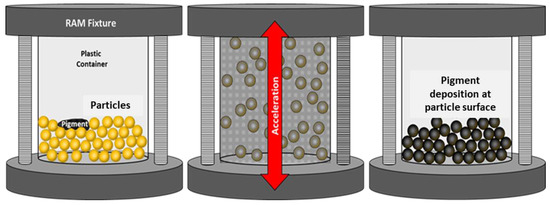
Figure 1.
Schematic shown of the coating process prior to the subsequent sintering stage Adapted from Ref. [14] (modified).
Subsequently, a heat treatment at 1200 °C was applied for 2 h to ensure the bonding of pigment to the particle surface. Details of the coating method can be found in a previous publication [14]. A muffle furnace was used to apply thermal aging to the particles at 1000 °C for 1 week to estimate their long-term optical endurance.
Phase components were analyzed via X-ray powder diffraction (XRD) with a D8 Advance Diffractometer with Cu-Kα configuration for 2θ between 10° and 80° (Bruker AXS, Karlsruhe, Germany). A high-temperature XRD stage (HTK 1200N, Anton Paar, Graz, Austria) was used to evaluate in situ phase reactions and interaction between the initial pigment mixture and as-received particles. EVA software was used to identify the phase components. Lattice parameters of spinel compound with increasing temperature were estimated using the cell tuning function of the EVA software, which uses graphical adjustment of peak positions via tuning of lattice parameters. Microstructure and chemical analysis were performed on coated particle cross sections by scanning electron microscopy (SEM; Ultra 55, Zeiss, Wetzlar, Germany) and energy-dispersive spectroscopy (EDS; UltiMate, Oxford, Abingdon, UK). For the cross-section analysis, particles are embedded into the commercially available epoxy resin. Surface investigations of the particles were performed via SEM in a low vacuum condition (SU 3800, Hitachi High-Tech Europe, Krefeld, Germany). Optical properties and absorptance of the particles were measured by spectrometry with an internal integrating sphere of 150 mm diameter (Lambda 950, Perkin Elmer, Hessen, Germany) according to the method described by Gobereit et al. [16]. Evaluation and solar weighting (ASTM G 173—03 direct + circumsolar) were performed in the range of wavelengths from 320 nm to 2500 nm with a measurement error smaller than 1%.
Solar weighted absorptance measurement was used to determine and quantify the success of the coating process and stability against the thermal degradation. The obtained results were explained using electron microscopy results which revealed the surface morphology and the appearance and chemistry of the coating layer in as-coated and after thermal aging. In situ phase investigation was used to reveal the phase interaction between pigment and particle to allow us to understand the formation mechanism.
3. Results and Discussion
3.1. Microstructural Analyses of As-Received and Coated Particles
As-received iron oxide particles were investigated via SEM to reveal the details of the microstructure. SEM micrographs, in addition to optical microscopy images of the as-received iron oxide particles, are represented in Figure 2.

Figure 2.
(a) Optical microscope image and SEM micrographs of as-received iron oxide granulate: (b) surface and (c) cross section.
The optical microscopy image in Figure 2a shows the appearance of as-received iron oxide particles highlighting their grey-brownish color and the pronounced surface roughness. Microstructures of the surface and cross sections in Figure 2b,c exhibit typical granulation morphology, where primary sub-micron-sized grains agglomerate into the spherical-like particles with a certain amount of porosity.
In order to assess the potential of increased solar absorptance by additional surface modification, iron oxide-rich particles were coated with deep black pigment using the same coating and sintering parameters for bauxite proppants, as reported in our previous study [14]. Figure 3 depicts the visual appearance and SEM/EDS mapping of iron oxide particle cross sections at the surface after deep black pigment coating.

Figure 3.
(a) Optical microscope picture SEM/EDS (b) Fe, (c) Al, and (d) Cu mapping of iron oxide granulate coated with deep black pigment.
Except for a shiny appearance, visual appearance and optical microscopy indicates very little change in surface color after deep black coating of gray-brownish iron oxide particles (Figure 3a). SEM cross sections also do not show formation of a clearly distinguishable coating layer containing cations from the black pigment, in particular Cu. The EDS maps in Figure 3d reveal Cu diffusion deep into the particle’s inner volume, where accumulation of Cu seems to occur preferably in Al-rich regions. This rapid diffusion of key black pigment components into the bulk material is evidently unfavorable in terms of improved optical properties. This behavior is in strong contrast to the coating of bauxite proppants, where the formation of a well-defined crystalline Fe-Al-Mn-Mg-Cu spinel layer was observed at the surface of the proppants.
In case of bauxite proppants, a high-temperature stable Fe-Al-Mn-Mg-Cu spinel formed through the reaction between black pigment (Fe-Mn-Cu) and Al and Mg components of bauxite. Considering the much lower initial Al content of new iron oxide particles, a new coating composition was developed in which external Al resource was introduced to the initial deep black powder. Through Al incorporation, mimicking of the high-temperature stable Fe-Cu-Mn-Al spinel was targeted. Metallic Al was preferred to alumina powders to utilize the melting of Al beyond 660 °C, which should lead to a more uniform and homogenous coating layer and may contribute to a better reaction and eventually incorporation of Al to the deep black pigment.
Figure 4 illustrates the appearance of iron oxide particles coated with Al-deep black mixture and the SEM/EDS mapping of cross sections.

Figure 4.
(a) Optical microscope picture and EDS (b) Fe, (c) Al, (d) Cu mapping of an iron oxide granulate coated with deep black + Al mixture.
The optical microscopy image reveals the successful coverage of the iron oxide particles with the coating mixture of (85 wt.%) deep black pigment and (15 wt.%) Al, where a darker color and smoother surface can be observed. Moreover, EDS mappings reveal a well-defined Cu-rich coating layer at the surface of particles, on the contrary to the particles coated with deep black pigment only (Figure 3). These results indicate that it is possible to prevent the diffusion of pigment cations, in particular Cu, to the inner structures of the particle and promote the Al-rich spinel formation through the addition of metallic Al.
3.2. Solar Absorptance and Its Long-Term Evolution
Beyond qualitative analysis provided by SEM cross sections and macro examination, the solar absorptance was measured via spectrometry to quantify the optical properties. Figure 5 represents the solar absorptance in the 320–2500 nm range for as-received, ‘Al-deep black’ coated and thermally aged iron oxide particles, respectively. Moreover, solar weighted absorptance of the particles was calculated according to ASTM 173d standards and is listed in the inset of Figure 5.
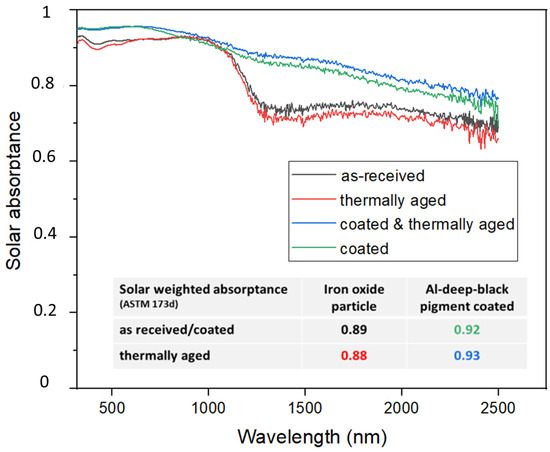
Figure 5.
Solar absorptance of as-received and coated iron oxide particles before and after thermal aging (TA). The inset table presents the calculated solar weighted absorptances after ASTM 173d.
Iron oxide particles in as-received condition exhibit a solar weighted absorptance of 0.89, which decreases slightly after 1-week thermal aging at 1000 °C to 0.88. To begin with, these new particles exhibit negligible absorptance loss when compared with bauxite proppants, which had lost almost 15% of as-received solar absorptance as previously reported. [13,14]. Beyond highly promising optical performance of as-received iron oxide particles, spectrometric analysis given in Figure 5 proved their further enhancement through the ’Al-deep black´ coating from 0.89 and 0.92. These spectrometric analysis results are in line with SEM/EDS mappings and optical microscopy findings (Figure 4), in which a surface-localized coating layer had been observed. Coated iron oxide particles were also exposed to thermal aging in identical conditions with as-received particles. Figure 5 revealed that such additional high-temperature annealing increased the solar absorptance of coated particles slightly from 0.92 to 0.93. This ‘in-operando’ blackening effect indicated that thermal storage provided slight improvement rather than thermal degradation, as observed for uncoated particles.
Low-vacuum SEM was used to provide the details of the surface structure of the as-received, coated and thermally aged samples to better understand the quantitative results obtained via spectrometry. The surface microstructures of as-received particles before and after thermal aging and EDS mapping of coated surfaces before and after thermal aging are given in Figure 6. Well-defined surface crystals with relatively fine size distribution are observed in the as-received state, as given in Figure 6a. After thermal aging at 1000 °C for one week, significant grain growth and slight pore coalescence can be observed (Figure 6b), which may be responsible for the minor decrease in solar absorptance. Propitious long-term optical properties are owing to their more stable and well-crystallized surface features revealed via surface analysis.
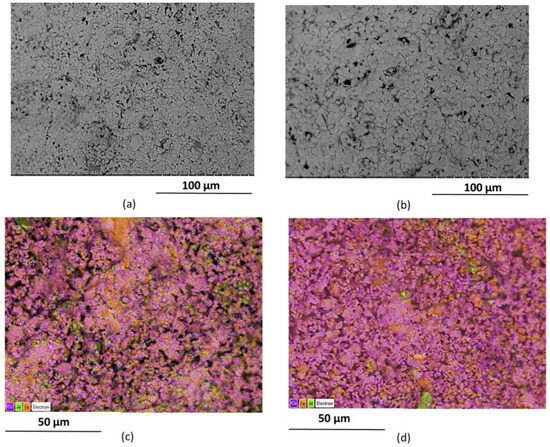
Figure 6.
Details of surface microstructures of (a) received (b) thermally aged, EDS mappings of (c) coated and (d) coated and thermally aged iron oxide particles.
Figure 6c provides further insight to the beneficial effect of ‘Al-deep black’ coating, in addition to the cross section mappings in Figure 4. It is possible to observe a poorly packed coating layer with non-uniform porosity distribution (Figure 6a). Higher porosities are observed around Al-rich spots, which are marked by the green color (Figure 6c). Less porous regions exhibited a similar structure to that observed in our previous study [10], where the reaction between deep black pigment and Al2O3 to stable spinel grains was completed. In the present case, several Al2O3-rich spots with different surrounding morphology at the surface point out an incomplete Al incorporation to spinel and, thus, a relatively slow formation of a stable, chemically homogeneous coating. After exposure to 1000 °C for one week, a more compact surface layer was achieved as represented in Figure 5d. Moreover, it is also possible to observe a more chemically and structurally homogenous nature of the coating after thermal aging with respect to the as-received particles (Figure 6d).
In the light of the spectroscopic analysis and SEM/EDS results, it can be assumed that the addition of Al powders to the black pigment changes the coating microstructural evolution and reaction path in such a way that significantly longer sintering times are required to reach the anticipated equilibrium state. This effect may also apply to the slightly improved optical properties after thermal aging (Figure 5), which can be regarded as a further sintering step improving surface homogeneity and associated solar absorptance of coated particles rather than their thermal degradation. To verify this concept, a two-hour additional sintering at 1200 °C was applied to the samples in order to provide enough time for the final stabilization of the coating; the corresponding EDS mappings of the cross-sections are presented in Figure 7.
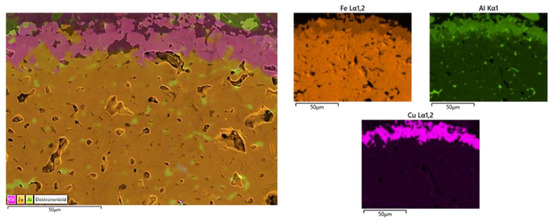
Figure 7.
SEM/EDS mapping of a coated iron oxide particle with additional 2 h of sintering.
Through the additional sintering step, a denser, well-consolidated and integrated coating layer is achieved when compared with one-step sintered particles (Figure 4). It is also worth emphasizing that, despite elongated sintering time, a well-defined interface between the coating layer and particle in EDS mappings confirms that diffusion of pigment cations, in particular Cu, into the particle volume is effectively mitigated by added Al. Al-modified deep black coatings with elongated sintering time can thus be considered very promising in terms of long-term optical stability and process efficiency.
3.3. Elucidating the Role of Added Al in Reactions and Microstructural Evolution of Deep Black Pigment
Obviously, Al incorporation into the initial pigment mixture changed the coating mechanism, postponed the completion of equilibrium phase formation, and required a longer sintering time. Metallic aluminum in the coating mixture may be acting as a reducing agent for Fe, Mn and Cu components of the pigment due to its strong oxygen affinity [17]. On the other hand, the formation of intermediate compounds may also prolong the formation of thermally stable spinel formation. In order to better understand the effect of the Al on the coating mechanism, additional analyses were performed.
In order to monitor the effect of metallic Al on the spinel formation during the sintering stage, the sinter process was mimicked and simultaneous phase changes were recorded in situ by HT-XRD. Iron oxide particles with a dry-coated Al-deep black pigment layer were heated up to 1200 °C and this temperature was maintained for 2 h. No evidence for the formation of α-Al2O3 (corundum) was found in HT-XRD-profiles. The change in the cubic spinel lattice parameter was recorded as a function of increasing temperature by the cell tuning function of EVA software and is plotted in Figure 8. Upon heating from room temperature, the increasing lattice parameter of the spinel occurred due to normal thermal expansion at elevated temperatures. However, this linear trend obviously faded out above 800 °C. A peak lattice parameter was reached at 1000 °C, which also marked the onset of a lattice parameter decrease in spinel up to the temperature maximum of 1200 °C. During the first 60 min of the dwell period at 1200 °C, a further significant decrease in the lattice parameter was observed. After 60 min, a steady state seemed to be evolving.
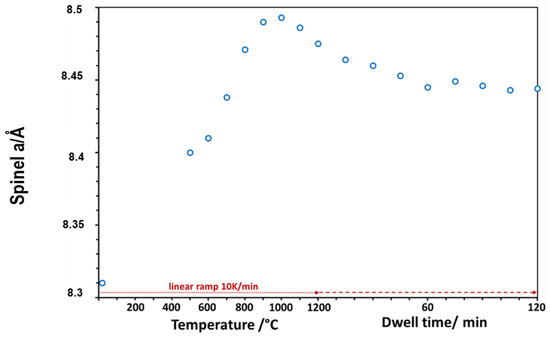
Figure 8.
HT-XRD: temperature and time-dependent change in the spinel lattice parameter.
A plausible reason for the observed evolution of the lattice parameter is obviously the progressive incorporation of Al having a smaller atomic size to the Fe, Cu, Mn spinel structure. In order to detect if there is an intermediate compound formation and to better understand the Al-pigment-iron oxide interaction, a quenching experiment was performed at the onset temperature of lattice parameter decrease determined by HT-XRD analysis. Particles are taken out of the furnace at 1000 °C to allow fast cooling rates to keep metastable phases at RT. SEM/EDS mapping of the quenched particle’s cross section is given in Figure 9.

Figure 9.
SEM/EDS Mapping of coating layer on iron oxide particle surface after quenching from 1000 °C revealing high (x1), low (x2) and intermediate (x3) Al spots.
Firstly, it is worth noting that there is no metallic Al or other metallic pigment components in the system. All components were oxidized and no partial reduction of Cu, Fe, Mn was detected despite the high oxygen affinity of Al.
EDS spot analyses of quenched particles marked in the EDS mapping (Figure 9) are given together with the cation composition of initial coating powder mixture and as-coated particles (Figure 4) in Table 1 for direct comparison purposes.

Table 1.
As quenched grain compositions (spot #1–#3) compared to starting pigment and as processed spinel coatings compositions in atomic percent measured by EDS.
EDS mapping of quenched coated particles revealed an inhomogeneous chemical composition with three typical variants. High-Al areas are frequently found close to larger former Al particles and are enriched in Cu with respect to Mn and Fe (spot #1). Low-Al areas (spot #2) also show some relative depletion of Cu, which is seemingly replaced by Al. Intermediate-Al areas (spot #3) show a composition where all other cations are detected in similar amounts. It must be emphasized, however, that spot analyses from the 1000 °C quenched sample are only a snapshot of ongoing cation migration and should only be regarded as a general trend. A simplified schematic of a plausible cation migration sequence is presented in Figure 10.
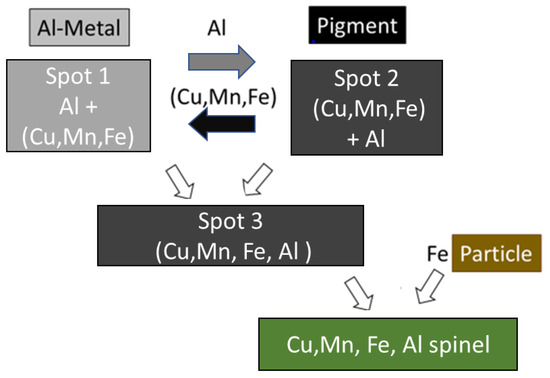
Figure 10.
Simplified schematic of the cation migration sequence as concluded from EDS analyses given in Table 1. As a key effect, a mutual affinity of Cu and Al is considered.
The relative enrichment of Cu at Al as well the enrichment of Al in (Cu,Mn,Fe)-rich grains, obviously former pigment, can be explained as interdiffusion caused by a relative high mutual affinity of Cu and Al. It is reported in previous studies that when the defect spinel γ-Al2O3 polymorph of alumina and CuO co-exist, the formation of a CuAl spinel is thermodynamically favorable [18]. During sintering of the Al-deep black pigment powder mixture, the melting of Al initially takes place. Upon subsequent Al oxidation, the presence of Cu may stabilize an Al-rich, spinel-type polymorph (spot #1) similar to γ-Al2O3 rather than corundum [19]. The other, low Al-spinel phase can be regarded as deep black pigment after out-diffusion of Cu and corresponding in-diffusion of Al (spot #2). In between both areas, the chemical composition may be explained by progressive interdiffusion of low-Al and high-Al spinels (spot #3). After processing at 1200 °C, a uniform Cu, Mn, Fe, Al-spinel coating can be achieved via mostly finished cation interdiffusion (Table 1). Due to the affinity between spinel-type alumina and Cu oxide, Cu in particular can effectively be captured at the surface and high-temperature stable Fe-Mn-Cu-Al spinel formation occurs without the loss of pigment components by diffusion into the bulk iron oxide particle. On the other hand, chemical homogenization requires a significant amount of time; therefore, better results were obtained during a second sintering step at 1200 °C. As-processed coatings show additional incorporation of Fe rather than inward diffusion of other cations. This can be explained by the different crystal structures, which favor the stabilization of a multi-cation, spinel solid solution rather than a α-Fe2O3-type solid solution. A further analysis including a detailed discussion of cation oxidation states or site preference in spinel- or α-Fe2O3-type structures is evidently highly complex and would require much more experimental effort. This is beyond the scope of this work. Here, we can only focus on our general concept, which involves specific modification of Cu-rich black pigment with Al, an effective stabilization of a high-temperature stable spinel-type phase with favorable optical properties.
4. Conclusions
Iron oxide particles are blackened by a ’resonant acoustic mixing’ dry coating method followed by a sintering process to enhance their long-term solar absorptance. In order to inhibit the diffusion of the deep black pigment into the inner parts of the iron oxide particle, an external aluminum source was added to the dry coating mixture. Aluminum was added to the system in the metallic form, which melts and oxidizes into the spinel-type γ-Al2O3 polymorph in the presence of Cu and ensures the formation of the Cu, Mn, Fe, Al spinel coating layer while diffusion of Cu and Mn into iron oxide particles is effectively mitigated. After a subsequent sintering process at 1200 °C for 2 h, solar absorptance of as-received iron oxide particles was enhanced from 0.89 to 0.92. The analysis of thermally aged particles at 1000 °C for 1 week revealed a further enhancement of solar absorptance to 0.93. Structural analysis showed the formation of a non-stochiometric spinel coating with Cu-Al rich and Fe-Mn rich regions. Therefore, for chemically homogeneous Al-deep black coating of iron oxide particles, longer sintering times at 1200 °C is proposed in order to achieve high-temperature stable Fe-Mn-Al-Cu spinel formation, which is highly promising for the application of such coated particles in CSP. Moreover, this study indicates that RAM followed by reaction sintering is a promising, flexible and easily applicable coating method on various particle types to achieve structurally and optically stable coatings through proper selection of materials and process parameters.
Author Contributions
Conceptualization, G.A. and P.M.; methodology, G.A. and P.M.; investigation, G.A., P.M. and J.P.; data curation, G.A., P.M. and J.P.; writing—original draft preparation, G.A. and P.M.; writing—review and editing, G.A, P.M. and J.P. All authors have read and agreed to the published version of the manuscript.
Funding
This project has received funding from the European Union’s Horizon 2020 Research and Innovation Action (RIA) under grant agreement No. 958418.
Data Availability Statement
Data are contained within the article.
Conflicts of Interest
The authors declare no conflict of interest.
References
- Klyuev, R.; Gavrina, O.; Madaeva, M. Benefits of Solar Power Plants for Energy Supply to Consumers in Mountain Territories. In Proceedings of the 2019 International Multi-Conference on Industrial Engineering and Modern Technologies (FarEastCon), Vladivostok, Russia, 1–4 October 2019; pp. 1–6. [Google Scholar] [CrossRef]
- Miravet-Sánchez, B.L.; García-Rivero, A.E.; Yuli-Posadas, R.A.; Inostroza-Ruiz, L.A.; Fernández-Guzmán, V.; Chávez-Juanito, Y.A.; Rutti-Marin, J.M.; Apesteguia-Infantes, J.A. Solar photovoltaic technology in isolated rural communities in Latin America and the Caribbean. Energy Rep. 2022, 8, 1238–1248. [Google Scholar] [CrossRef]
- Assareh, E.; Parvaz, M.; Hoseinzadeh, S.; Lee, M. A new analysis for a concentrated solar power-based cogeneration system with molten salt energy storage and heat recovery steam generator—Case study—(USA, France, Canada). Renew. Energy Focus 2023, 46, 256–280. [Google Scholar] [CrossRef]
- Abdelrazik, M.K.; Abdelaziz, S.E.; Hassan, M.F.; Hatem, T.M. Climate action: Prospects of solar energy in Africa. Energy Rep. 2022, 8, 11363–11377. [Google Scholar] [CrossRef]
- Ho, C.K.; Iverson, B.D. Review of high-temperature central receiver designs for concentrating solar power. Renew. Sustain. Energy Rev. 2014, 29, 835–846. [Google Scholar] [CrossRef]
- Nie, F.; Bai, F.; Wang, Z.; Li, X.; Yang, R. Solid particle solar receivers in the next-generation concentrated solar power plant. EcoMat 2022, 4, e12207. [Google Scholar] [CrossRef]
- Buck, R.; Giuliano, S. Solar Tower System Temperature Range Optimization for reduced LCOE. AIP Conf. Proc. 2019, 2126, 030010. [Google Scholar]
- Amsbeck, L.; Behrendt, B.; Prosin, T.; Buck, R. Particle Tower System with Direct Absorption Centrifugal Receiver for High Temperature Process Heat; Solarpaces: Bejing, China, 2014. [Google Scholar]
- Palacios, A.; Barreneche, C.; Navarro, M.E.; Ding, Y. Thermal Energy Storage Technologies for Concentrated Solar Power—A Review from a Materials Perspective. Renew. Energy 2020, 156, 1244–1265. [Google Scholar] [CrossRef]
- Siegel, N.; Gross, M.; Ho, C.; Phan, T.; Yuan, J. Physical Properties of Solid Particle Thermal Energy Storage Media for Concentrating Solar Power Applications. Energy Procedia 2014, 49, 1015–1023. [Google Scholar] [CrossRef]
- Siegel, N.; Gross, M.; Coury, R. The development of direct absorption and storage media for falling particle solar central receivers. J. Solar Energy Eng. 2015, 137, 041003. [Google Scholar] [CrossRef]
- Roop, J.; Jeter, S.; Abdel-Khalik, S.; Ho, C. Optical properties of select particulates after high-temperature treatment exposure. In Proceedings of the 8th International Conference on Energy Sustainability, Coimbra, Portugal, 3–5 July 2019. ES2014-6504. [Google Scholar]
- Alkan, G.; Mechnich, P.; Barbri, H.; Flucht, F.; Sergeev, D.; Müller, M. Evaluation of Ceramic Proppants as Heat Transfer and Storage medium. In Proceedings of the 27th SolarPACES Conference, Online, 27 September–1 October 2021. in press. [Google Scholar]
- Alkan, G.; Mechnich, P.; Pernpeinter, J. Improved Performance of Ceramic Solar Absorber Particles Coated with Black Oxide Pigment Deposited by Resonant Acoustic Mixing and Reaction Sintering. Coatings 2022, 12, 757. [Google Scholar] [CrossRef]
- Resodyn Acoustic Mixers, Milling and Coating with RAM. Available online: https://resodynmixers.com/download/milling-and-coating-with-ram/ (accessed on 29 April 2022).
- Gobereit, B.; Amsbeck, L.; Happich, C.; Schmücker, M. Assessment and improvement of optical properties of particles for solid particle receiver. Sol. Energy 2020, 199, 844–851. [Google Scholar] [CrossRef]
- Jeffes, J.H.E. Encyclopedia of Materials: Science and Technology; Pergamon: Oxford, UK, 2001. [Google Scholar]
- Tang, Y.; Sin-Yin Chui, S.; Shih, K.; Zhang, L. Copper Stabilization via Spinel Formation during the Sintering of Simulated Copper-Laden Sludge with Aluminum-Rich Ceramic Precursors. Environ. Sci. Technol. 2011, 45, 3598–3604. [Google Scholar] [CrossRef] [PubMed]
- Levin, I.; Brandon, D. Metastable Alumina Polymorphs: Crystal Structures and Transition Sequences. J. Am. Ceram. Soc. 1998, 81, 1995–2012. [Google Scholar] [CrossRef]
Disclaimer/Publisher’s Note: The statements, opinions and data contained in all publications are solely those of the individual author(s) and contributor(s) and not of MDPI and/or the editor(s). MDPI and/or the editor(s) disclaim responsibility for any injury to people or property resulting from any ideas, methods, instructions or products referred to in the content. |
© 2023 by the authors. Licensee MDPI, Basel, Switzerland. This article is an open access article distributed under the terms and conditions of the Creative Commons Attribution (CC BY) license (https://creativecommons.org/licenses/by/4.0/).